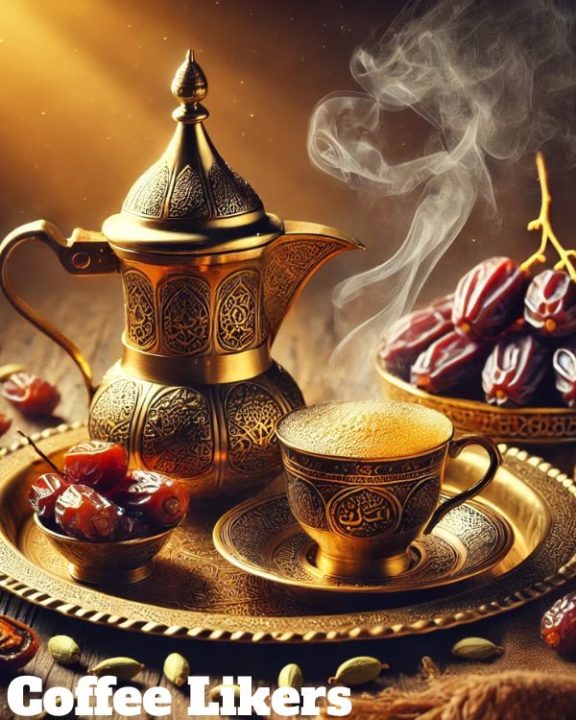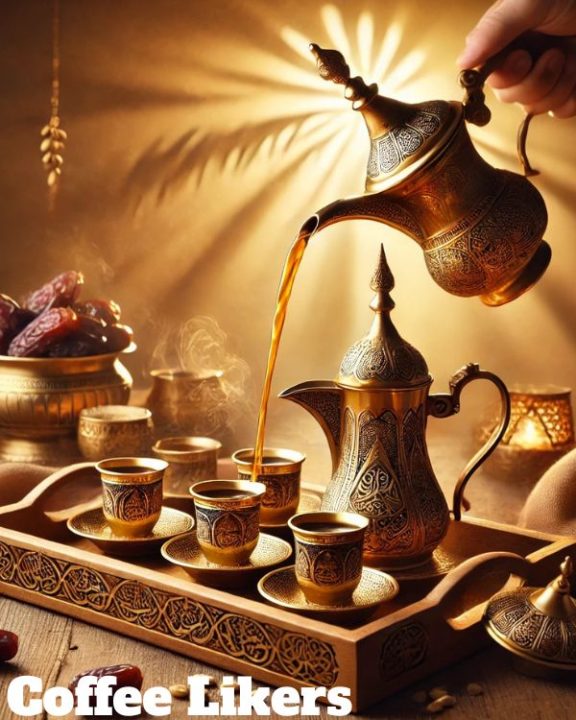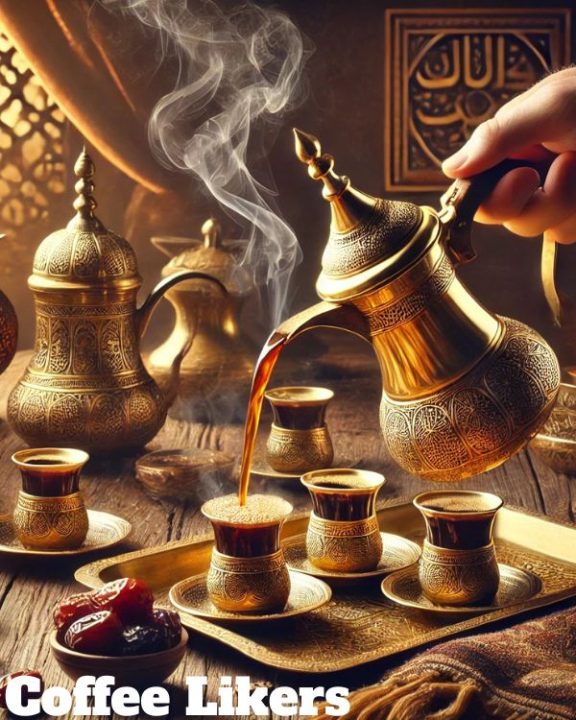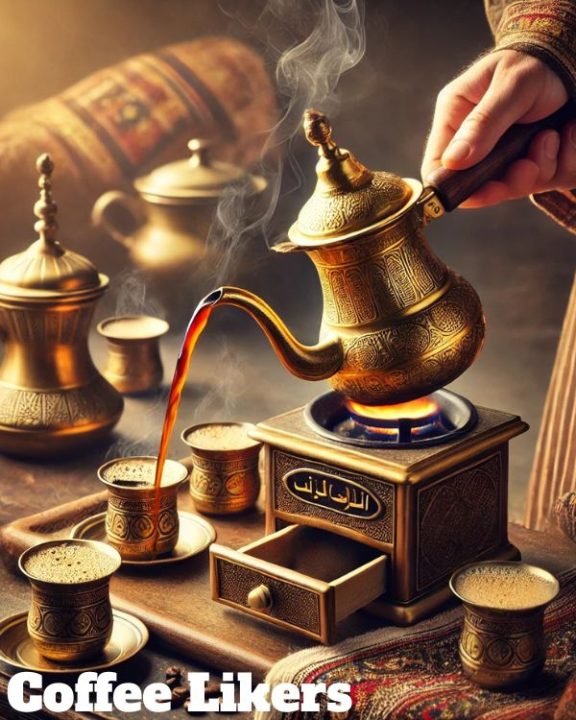Arabic coffee, or qahwa, is an important part of Middle Eastern culture. More than just a drink, it shows warmth and hospitality. Served to guests as a sign of respect, it follows special traditions and rituals.
Made from carefully selected beans, Arabic coffee is roasted, ground, and brewed with cardamom, saffron, and other spices. It is prepared in a dallah and served in small cups called finjans.
This blog explores how to prepare Arabic coffee, the traditions, and the cultural importance of Arabic coffee. Join us in discovering how this fragrant drink brings people together and creates a sense of togetherness.
How do you make traditional Arabic coffee? Traditional Arabic coffee, also known as “qahwa,” is made by brewing finely ground coffee with spices like cardamom, cloves, and saffron. The coffee is boiled multiple times, creating a foam on top. This foam indicates that the coffee is fully brewed and ready to be enjoyed.
How To Prepare Arabic Coffee: Brief Description
Making Arabic coffee is a special skill passed down through generations. It’s not like your usual coffee. You need specific tools and each step, from picking the beans to serving the drink, is crucial for the authentic taste.
This guide will show you how to make Arabic coffee so you can enjoy this beloved tradition at home. We’ll cover everything, from the ingredients you need to the significance of each sip.

Steps To Make Arabic Coffee
Brewing the perfect cup of Arabic coffee is easy if you follow these steps:
- Prepare the Coffee Pot: First, rinse your coffee pot, like a dallah or a Turkish cezve, with hot water. This helps keep the temperature steady while brewing.
- Heat the Water: Next, pour the amount of water you want into the coffee pot. Put it on medium heat and let the water boil.
- Add the Coffee: When the water is boiling, take the pot off the heat. Add the ground coffee and stir gently. Put it back on low heat and let it simmer. This helps the coffee flavor to come out well.
Ingredients For Arabic Coffee
The special taste of Arabic coffee comes from its unique ingredients:
- Arabica Beans: The main ingredient of this drink is fine Arabica beans. Choose a light or medium roast that is finely ground. This helps to bring out the best flavor.
- Cardamom: This spice is essential for Arabic coffee. It adds a warm, lightly sweet, and fruity flavor. You can use already ground cardamom or crush the pods to get fresh seeds for a stronger smell.

- Water: The type of water you use is very important for the taste. Filtered or spring water is best. This keeps the flavor clean and does not mask the coffee and spices.

Traditional Arabic Coffee Recipe
Here’s a simple recipe for making traditional Arabic coffee:
- First, grind 2 tablespoons of light roast Arabica beans into a fine powder using a coffee grinder.
- Next, take 1 tablespoon of cardamom pods. Crush them lightly with a mortar and pestle. This will bring out their nice smell. Then, remove the seeds and grind them finely.
- After that, mix the coffee grounds and the cardamom seeds in a bowl. Store this mixture in an airtight container to keep it fresh.
Arabic Coffee Preparation Method
The making process is important for creating a yummy cup of Arabic coffee:
- First, take a special pot and heat 2 cups of water. Then, add 2-3 spoons of the coffee and cardamom mix.
- Next, reduce the heat. After 10-15 minutes, let it simmer gently. This helps the flavors mix well.
- Last, while the coffee cooks, a light foam will form on top. This foam, called “qahwa,” shows that you have

made a good Arabic coffee. Serve it right away in small cups. Keep any extra coffee on low heat to stay warm.
The Importance Of Using Finely Ground Arabica Coffee Beans
The kind of coffee beans you pick makes a big difference in how your Arabic coffee tastes. Arabica beans are well-liked because they have smooth and complex flavors. It’s crucial to use a coffee grinder to make the beans into a fine powder.
This fine grind gives more surface area. This helps the hot water pull out the rich aromas and oils from the beans. The result is a more delicious and aromatic cup of coffee.

The Significance Of Arabic Coffee In Middle Eastern Culture
In the Middle East, Arabic coffee is more than just a drink. It is a way to show kindness and tradition. People often serve it at parties, gatherings, and in everyday life.
When visitors come over, it is common to welcome them with a cup of Arabic coffee. This gesture demonstrates warmth and respect.
Serving Arabic coffee is connected to being generous and having good manners. The host uses their right hand to pour coffee into small cups, filling each one halfway. Guests usually receive multiple servings, and refusing a cup could be seen as impolite.
Traditional Tools And Equipment Needed For Preparing Arabic Coffee
To make real Arabic coffee, it’s important to have the right tools. Here’s what you’ll need:
- Coffee Grinder: This is used to grind coffee beans into a fine powder to get the best flavor.
- Coffee Pot (Dallah): This is a traditional pot for brewing and serving Arabic coffee. It has a long spout for pouring and is often decorated.
- Small Cups: These handleless cups are used to serve Arabic coffee to keep it hot and make it taste better.
| Tool | Description | Alternative |
| Coffee Grinder | To make fine powder from coffee beans. | Mortar and pestle |
| Coffee Pot (Dallah) | A traditional pot used for brewing and serving Arabic coffee. | Turkish cezve, small saucepan |
| Small Cups | Handleless cups are used to serve Arabic coffee. | Small espresso cups |
Understanding The Traditional Brewing Method For Arabic Coffee
Traditional Arabic coffee making is very different from how coffee is made in the West. How to prepare Arabic coffee, when making Arabic coffee, the coffee is not filtered. In the cup, the grounds settle to the bottom.
The key is to boil the coffee multiple times. During this process, spices like cardamom and sometimes cloves are added. This slow brewing allows the coffee to show its full flavor.
The result is a rich, strong, and fragrant drink. The “qahwa,” which is the foam on top, is a special feature of a good cup of Arabic coffee.

Adding Cardamom For An Authentic Flavor Profile
Cardamom is really important for the taste of Arabic coffee.
These fragrant pods mix sweet and savory flavors to create a unique depth.
Use freshly ground cardamom to get the best flavor. Many people also add a bit of saffron with the cardamom.
This makes the coffee smell better and gives it a lovely golden color, making it look nice too.
Boiling Water To The Perfect Temperature For Brewing
Getting the water temperature right is very important for making Arabic coffee.
Using hot water helps bring out the flavors and smells of the coffee grounds.
But you should wait a little while for the water to cool down before adding the coffee.

Pouring extremely hot water directly onto the coffee grounds can make it taste burnt. Waiting a short while for the water to cool can help preserve the delicate flavors and aromas. This way, you can have a tastier and more balanced cup of coffee.

The Significance Of Serving Arabic Coffee In Small Cups
Serving Arabic coffee in small cups is more than just a tradition; it makes the whole experience better.
These tiny cups usually don’t have handles. They fit nicely in your hand, letting you enjoy the coffee’s smell and warmth.
It is common to serve coffee with your right hand as a sign of respect and
hospitality. Taking the cup with your left hand is seen as rude. The small servings invite more refills. This way, hosts and guests can keep talking and enjoying each other’s company.
How To Properly Present And Serve Arabic Coffee To Guests?
Serving Arabic coffee is like a special skill. The coffee usually comes in a pretty metal pot with a long spout called a dallah. This pot symbolizes generosity and abundance. The host uses their right hand to pour the coffee into small cups placed on a tray.
Guests are served first. The oldest or most respected guest gets the first cup. It’s polite to have at least one cup. Guests typically drink around three cups during their visit.

Understanding The Cultural Rituals Associated With Serving Arabic Coffee
Serving Arabic coffee in the Middle East is more than just drinking a drink. It is a cultural tradition that shows kindness and honor. This practice helps bring people together.
An important part of this tradition is the ‘qahwa,’ which is the froth on top of the coffee. The host should always make sure each cup has good froth. If someone says no to a cup of Arabic coffee, it can be seen as impolite and a violation of social norms.
Tips For Enhancing The Flavor And Aroma Of Arabic Coffee
To make your Arabic coffee taste even better, follow these tips:
- Grind Your Spices Fresh: For a stronger smell, grind your own cardamom pods and any other spices you like, such as cloves or saffron.

- Avoid Over-Boiling: If you boil too much, the coffee can taste bitter. After it boils the first time, lower the heat and let it simmer.
- Warm Your Cups: Pour hot water into your serving cups before adding the coffee. This keeps the coffee warm longer.
Pairing Arabic Coffee With Traditional Sweets Or Dates For A Complete Experience
Arabic coffee is often enjoyed with sweet treats that go well with its strong taste. Dates are commonly eaten in Middle Eastern cuisine and are a popular choice. Medjool dates have a sweet flavor similar to caramel that complements the bitterness of the coffee.
Other popular options include baklava, a pastry filled with nuts and honey, and maamoul, which are cookies made with semolina and filled with dates or pistachios. In Saudi Arabia, Arabic coffee is often served with qatayef, sweet dumplings filled with cheese or nuts.

Pairing Suggestions With Traditional Arabic Sweets Or Dates For A Complete Experience
To make your Arabic coffee experience even more enjoyable, you can try these combinations with traditional sweets:
- Dates: Medjool dates are a great classic choice. You can also try different types like Deglet Noor or Zahidi.
- Chocolates: Dark chocolate with sea salt or orange peel complements the strong taste of the coffee.
- Nuts: Roasted almonds, pistachios, or cashews add a nice crunch and complement the coffee’s nutty flavors.
FAQ About How To Prepare Arabic Coffee
How To Prep Arabic Coffee?
To make Arabic coffee, begin by grinding Arabica coffee beans very fine. Next, boil some water in a dallah, which is an Arabic coffee pot. After that, add your ground coffee to the water. Let it simmer on low heat until the coffee tastes just right for you.
How Is Traditional Arabic Coffee Made?
Traditional Arabic coffee is prepared by brewing finely ground coffee beans with cardamom and some spices in a special coffee pot. The coffee is boiled several times. This process gives it a rich and flavorful taste.
Do You Add Milk To Arabic Coffee?
No, milk is not usually put in Arabic coffee. People often drink it black. This way, the flavors of the coffee and the spices can stand out.
What Is The Ratio For Arabic Coffee?
A basic rule for making Arabic coffee is to use 1 to 2 teaspoons of coffee grounds for every half cup of water. You can change this amount based on your taste as per your coffee cups.
Final Thought
Arabic coffee is more than a drink—it’s a tradition and a symbol of hospitality. By following these steps, you can bring this special custom into your home and share it with family and friends.
The rich aroma creates a warm and welcoming space for guests. Making Arabic coffee is not just about the taste but the experience and connection it brings.
From selecting beans to roasting and brewing, each step matters. By embracing this tradition, you enjoy more than a delicious drink—you celebrate togetherness.
In this article, we discussed how to prepare Arabic coffee, thanks for visiting our website. Cheers to the timeless tradition of Arabic coffee!





Leave a Reply